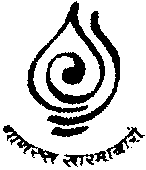
The soul has two states: that of acceptance of negative particles and that of non-acceptance of negative particles. To be in a state of pure knowledge is a state of non-acceptance. Knowledge is the nature of the soul. When it is in its very nature then falsities cannot enter and cause exchange of karmas or influence it.
Reacting to sensations is acceptance of negative matter. Through our sensations we establish contact with the outer world. We take something from the outside world and add it on to ourselves. This influx is called ashrava and bondage is called bandha. When the negative particles are bound to the soul and they ripen and begin to influence then it is called karma. It exhibits its influence and falls off. No elements are attached to the soul forever. It either waits for time to show its influence and then falls off or is thrown off by effort. This effort to shed it is called nirjara. With penance (tapasya) karmas are shed and that is why penance is also called nirjara. The culmination of penance is salvation (moksha). Moksha means only the soul exists. When soul and matter are bound together it is bandhan or bondage. It is a mundane state of the soul (sansar). When there is only the soul without matter that is the state of moksha it is the anti-thesis of mundane existence. It can be experienced at every moment of dharma.
Ashrava, samvara, bandha and nirjara - only on understanding these four principles can we understand the reality of karma. To experience only consciousness is samvara. To mix passions of attachment and aversion with the consciousness is ashrava. This attracts the atoms of karma. They limit the consciousness and reduce the capacity of knowledge and perception. By distorting the natural bliss of the soul they bring about deformities in the perspective and conduct. They reduce the strength of the soul. Some atoms of karma are causes for body-building and gain in matter. This way ashrava makes way for bandha and bandha in turn influences the soul with auspicious (punya) and sinful (papa) karmas. Till the soul reaches the state of kevala gyan (enlightenment) this cycle goes on.
Both the living and matter have infinite strength. The living have two types of strengths:
- labdhivirya - energy potential
- Karmavirya - energy in action
Gautama asked Bhagvan Mahavira, "Sir! Do souls bind the karma of view-deluding inclination?"
Bhagvan, "Yes they do."
"Sir, how?"
"Through remiss."
"Sir! Remiss by whom?"
"By activity of mind, body and speech."
"Sir, what is the origin of activity?"
"Life energy (Virya)"
"Sir, what causes the origin of virya?"
"The body."
"Sir, what causes the body?"
"The karmic body."
"Sir, what causes the karmic body?
"The soul is the origin of the body."
Let us go backwards. From living beings to body, from the body to work energy, from work energy to the force of the activities of mind, body and speech, from this combine to remiss and from remiss to karma-bandha is one sequence.
Is the creator of karma the soul or the body? There are two opinions. In the words of the Agamas, the creator of karma is the soul. Acharya Kundakunda however says that both perspectives are relative. There is no essential difference between the two. The soul as a substance (real consciousness) and modes of the soul (the states that occur with the stimuli of the soul) both these are objects. In them we see differences as well as similarities. When we look at it with the perspective of similarity we say the soul generates action. And when we look at it from the perspective of differences we say that karma generates action. That which creates karma is passion, which is the state of the bound soul (kashaya atma). It is one mode of the soul as a substance. If the soul as a substance is the creator of karma then it can never become the non-creator of it. Its nature is pure consciousness and so it can motivate only the consciousness. Acharya Mahaprajna
Acharya Mahaprajna


